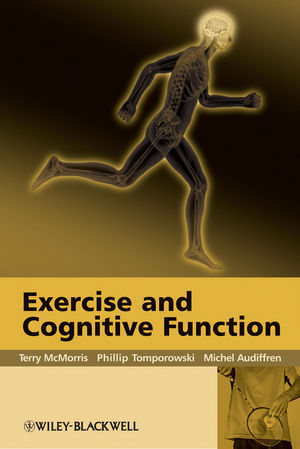Exercise and Cognitive FunctionISBN: 978-0-470-51660-7
Hardcover
400 pages
March 2009
 |
||||||
Preface ix
Contributors xi
PART 1 THEORETICAL AND METHODOLOGICAL ISSUES 1
1 Acute exercise and psychological functions: a cognitive-energetic approach 3
Michel Audiffren
1.1 Varieties of exercise effects on psychological variables 4
1.2 The cognitive psychology approach 9
1.3 The energetic approach 11
1.4 Exercise effects and cognitive-energetic models 14
1.5 Sensorimotor and cognitive functions affected by exercise 24
1.6 Limits of the cognitive-energetic approach and future perspectives 33
1.7 Conclusion 39
2 Exercise and cognitive function: a neuroendocrinological explanation 41
Terry McMorris
2.1 Catecholamines and 5-hydroxytryptamine as brain neurotransmitters 41
2.2 How exercise induces increases in brain concentrations of noradrenaline, dopamine, cortisol and 5-hydroxytryptamine 43
2.3 Exercise, catecholamines, cortisol and cognition: research 50
2.4 Task type 59
2.5 Discussion 63
2.6 Developing a neuroendocrinological model for an interaction between exercise and cognition 67
3 The transient hypofrontality theory and its implications for emotion and cognition 69
Arne Dietrich
3.1 Clearing the ground 71
3.2 Exercise-induced transient hypofrontality 73
3.3 Implications for emotion 79
3.4 Implications for cognition 81
3.5 Reconceptualizing the existing data in the field 87
4 Methodological issues: research approaches, research design, and task selection 91
Phillip D. Tomporowski
4.1 Research approaches 92
4.2 Research design issues 99
4.3 Task selection issues 106
4.4 Conclusions and recommendations 112
PART 2 ACUTE EXERCISE AND COGNITION 115
5 Exercise, dehydration and cognitive function 117
Terry McMorris
5.1 Exercise-induced dehydration and cognitive function 119
5.2 Discussion 128
5.3 Conclusions 134
6 Exercise, nutrition and cognition 135
Adam David Cunliffe and Gulshanara Begum
6.1 Fatigue and limits to human performance 136
6.2 Assessing the effects of exercise and nutrition on cognitive performance 138
6.3 Nutrition, exercise and cognitive performance 142
6.4 Micronutrients, exercise and cognitive performance 145
6.5 Nutritional ergogenic aids and cognitive performance 147
6.6 Integration of research observations 148
6.7 Challenges in research 150
6.8 Conclusion 151
7 A chronometric and electromyographic approach to the effect of exercise on reaction time 153
Karen Davranche and Michel Audiffren
7.1 Research 156
7.2 Conclusion 159
8 Acute aerobic exercise effects on event-related brain potentials 161
Charles H. Hillman, Matthew Pontifex and Jason R. Themanson
8.1 Executive control 163
8.2 Neuroelectric measurement 164
8.3 Event-related brain potentials during exercise 165
8.4 Event-related brain potentials following exercise 170
8.5 Future directions and conclusions 177
9 Exercise and decision-making in team games 179
Terry McMorris
9.1 Designing a decision-making test 180
9.2 Research results 183
9.3 Ecological validity and future research 189
9.4 Implications for team games players and coaches 192
10 Blood glucose and brain metabolism in exercise 193
Niels H. Secher, Thomas Seifert, Henning B. Nielsen and Bjørn Quistorff
10.1 Cerebral metabolism during exercise 194
10.2 Cerebral oxygenation 202
10.3 Cerebral metabolism 203
10.4 Acute hypoglycemia 209
10.5 Conclusions 209
10.6 Future research 210
Acknowledgements 210
PART 3 CHRONIC EXERCISE AND COGNITION 211
11 An integrated approach to the effect of acute and chronic exercise on cognition: the linked role of individual and task constraints 213
Caterina Pesce
11.1 The gap between acute and chronic exercise research 213
11.2 Individual constraints on the acute exercise–cognition relationship: the role of chronic exercise effects 215
11.3 Effect of physical fitness: links to exercise intensity and to the time relation between physical exercise and cognitive task 218
11.4 Effect of cognitive expertise: links to cognitive task complexity, exercise intensity and duration, and age 219
11.5 Effect of motor coordination skills: links to physical exercise complexity, intensity and duration 223
11.6 Bridging the gap between acute and chronic exercise studies 225
12 Chronic exercise and cognition in older adults 227
Jennifer Etnier
12.1 Theoretical underpinnings 228
12.2 Empirical evidence 230
12.3 Moderators of the relationship 245
12.4 Practical conclusions 245
12.5 Challenges 246
12.6 Future research 247
13 Exercise and cognition in children 249
Catherine L. Davis and Kate Lambourne
13.1 Definition of terms 249
13.2 Literature review 250
13.3 The Medical College of Georgia study 254
13.4 Potential mechanisms 262
13.5 Summary and recommendations for future research 266
14 Chronic exercise and developmental disabilities 269
James Zagrodnik and Michael Horvat
14.1 Defining terms 269
14.2 Research investigating the effects of exercise on cognition among the developmentally disabled 272
14.3 Problems to address and future research considerations 279
14.4 Practical applications and conclusions 282
15 Chronic exercise in brain diseases 285
Laura Eggermont and Erik Scherder
15.1 Observational studies of physical activity 286
15.2 Physical activity intervention studies 288
15.3 Physical activity, cognition and different types of dementia 298
15.4 Role of vascular disease 302
15.5 Neurodegenerative disease, nitric oxide, vascular disease and physical activity 305
15.6 Final conclusion 305
PART 4 DISCUSSION AND CONCLUSION 307
16 Summary and direction for future research 309
Terry McMorris, Phillip D. Tomporowski, and Michel Audiffren
16.1 Summary: emerging theoretical approaches 309
16.2 Summary of research results 312
16.3 Future theoretically driven research 314
16.4 Future applied research 316
16.5 General summary 317
References 319
Index 375



